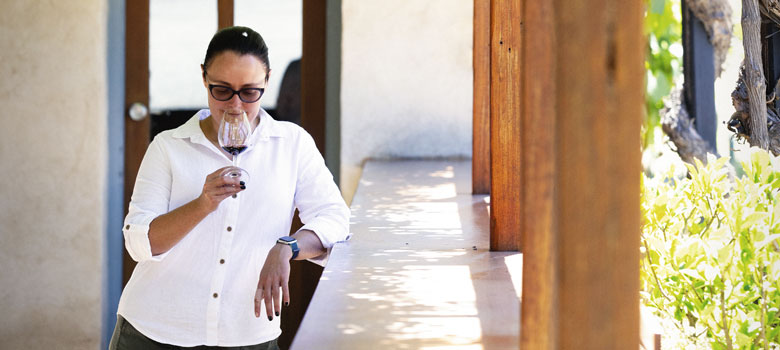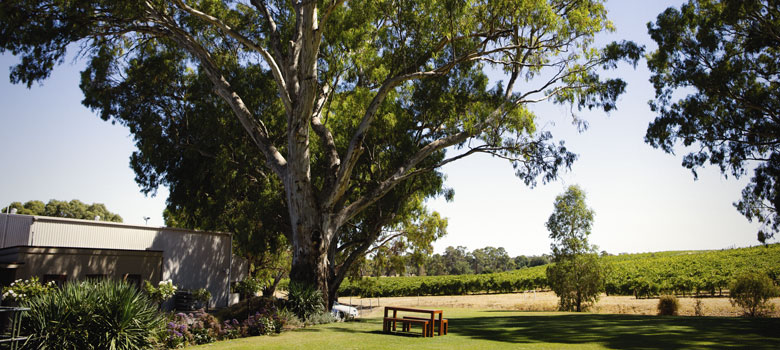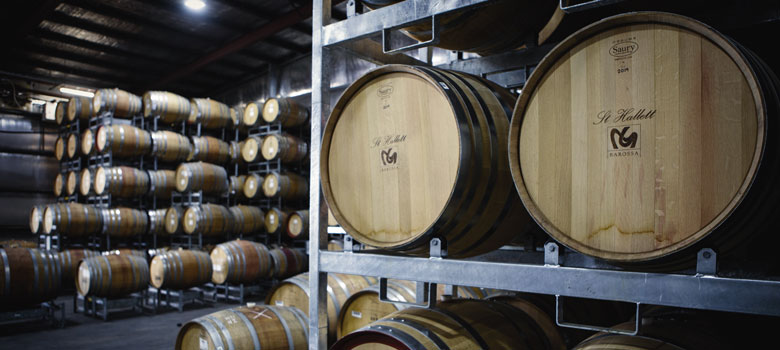
Wine
St Hallett Shiraz and Soul
Through a tasting going back decades, Selector gets to the people and the wines that have helped St Hallett endure for nearly 80 years.
Like most Barossa stories, this one starts with folk escaping persecution in Europe and ending up at the Lutheran settlement of Bethany. Johann Gottlob Lindner, his wife Maria Rosine and their four sons arrived in 1845 and bought land in what was known as the Hallett Valley, three kilometres from Tanunda.
Johann and Maria’s fourth son Carl Willhelm established a butcher shop on the property and in 1912 his sixth son Carl ‘Pop’ Lindner planted a half-acre of vines and began making fortified wine to sell and table wine for home consumption. Those vines, which still stand today, are now called ‘Old Block’, and are the foundation on which the St Hallett story rests.

In 1944, after finishing a winemaking apprenticeship at Orlando, Pop’s son, Carl Willhelm ‘Bill’ registered the name St Hallett and began making fortified wine. Competing with big names like Seppeltsfield, Penfolds, Orlando and Yalumba was tough and the Lindners were living hand-to-mouth selling Ruby Port to hotels and pubs and directly to the public through the winery window.
Of Bill’s three sons, Merv became a wheat farmer, Carl bought into some vineyards and as Bill’s health failed, Elmore left school at 14 to help in the winery. Carl eventually bought back into the business in 1974 and as the demand for table wine overtook fortified wine, the modern face of St Hallett emerged and with it the characters that shaped its wine and identity.
The Fixer and the Builder
The first character is Robert O’Callahan, who joined in 1972 as winemaker and general manger. Robert gained his reputation as the ‘fixer’ by steadying the St Hallett ship and saving it from financial ruin.
Robert also focussed on creating a distinctive Barossan Shiraz that was elegant, powerful and age worthy. In 1980 he produced the first St Hallett ‘Old Block’ Shiraz from the original 1912 plantings. This distinctive wine was the first from the Barossa to actively promote old vineyards on the label.
The first St Hallett Old Block Wine was Robert’s last and he moved on to eventually establish the iconic Rockford Wines. Stuart Blackwell, employed by Robert as assistant winemaker in 1972, was elevated to chief winemaker and he began modernising the winery, expanding the relationship with growers and gaining access to fruit from all over the Barossa.
This journey took St Hallett from a 70 per cent fortified to an 80 per cent table wine business within one year and the personality of St Hallett began to change. Stuart built a range of wines that expressed the various sub-regions within the Barossa and St Hallett’s reputation for expressive, character driven wines grew.

The Marketer of St Hallett
The 1980s was a boom time for Australian wine and as the shift from fortified to table wine solidified overseas, demand took off. Marketing quickly became an important part of the sales process and in 1987, Carl Lindner asked Bob McLean to join the St Hallett team as a partner. Having gained a positive reputation at Orlando and Petaluma, Bob brought ambition and vision to St Hallett.
Bob formulated a code of ethics to allow himself, Carl, Stuart and the team to create pillars around which the St Hallett brand was built. ‘Integrity’, ‘honesty’ and ‘truth’ appeared alongside the ‘100% Barossa’, ‘style’ and ‘small is beautiful’ mantras by which the team lived.
Bob also created a brand identity by commissioning Barossa artist Rod Schubert. The image Rod created, which can be seen on everything St Hallett, has the initials of the owners’ surnames L and M intertwined.
Tasting St Hallett
To get to this great story, St Hallett chief winemaker Helen McCarthy treated Selector to an epic tasting. Stretching back to the early 1990s, the tasting was as much a Barossan masterclass as it was a look under the hood of St Hallett.
Starting with a wine first made in 1991 and named in celebration of Stuart’s wife and a patch of vines next to the Barossa Lutheran Collage, ‘Faith’ has been the entry wine and workhorse for St Hallett for three decades.
Looking back a quarter of a century, Faith showed that for an entry level wine, it punches well above its weight. Stylistically counter intuitive, Faith is soft, elegant and rounded, rather than the big and blocky style of Barossa Shiraz that put the region on the map. Not only does Faith represent the current in-vogue style, the wines age beautifully.
Wine Selectors’ head of wine Matt White loved the 18 and 19 vintages for their, “clean, honest and approachable,” characteristics and Helen loved the 2018 for its potential as another 94 with its “lush and balanced layers of graciously aged dark berry fruits.”
Blackwell and Old Block
First made in 1994, Stuart’s namesake wine is made from fruit sourced from a core group of growers in the northern Barossa sub-regions, specifically Ebenezer and Greenock. These areas deliver a dark, heavily weighted blue and blackfruit driven wine that is in line with the archetypal Barossa Shiraz style.
With a bright and forward fruit structure, a soft middle palate and a fine tannin grip, the Blackwell wines are a fitting tribute to Stuart’s winemaking and Bob’s ‘100% Barossa’ mantra. These wines could not possibly be from anywhere else and are aged in American oak that gives them that unmistakably Barossan creamy, vanilla layer.
Left: Old and new – the original cellar and the modern tank of St Hallett; Right: The entrance to the Old Block cellar.
Everyone loved the 1996 for its regal poise, graceful age and structure. Helen was wowed by the 2003 for its power and fine tannin and Matt loved the 2018 for its fresh characters and long term potential.
As the flagship, Old Block represents elegance, detail, texture, structure and age-ability. Full-bodied, but not weighty, the grapes come from a selection of centurion vines from the original Old Block, valley floor and Eden Valley.
Detailed, balanced and elegant with a broad spectrum of concentrated bright red, blue and black fruits, spice, mocha, and silky tannins, the Old Block wines are impressive, and worthy of being considered amongst the best that the Barossa has to offer.
Everybody was blown away by the vibrant stature of the 94, with Helen singling out the interplay between spice and fruit in the 2015 and 2016 wines. Matt had similar compliments with the same wines and noted the appealing dried herb characters of the 2012 and the luscious generosity of the 2003.
The Future Range
The next bracket showed an evolution focussed on style and the varying terroir expressions of the Barossa.
First was the 2019 Black Clay Shiraz representing the Gomersal sub-region, which was full-bodied and generous with zesty layers of sweet black, blue and red fruits. A satisfying day-to-day wine for the lovers of classic Barossa Shiraz. Next was the 2018 Blockhead Shiraz Grenache – a delicious marriage of varieties expressing hedonistic layers of juicy red fruits, mocha and spice.
The 2018 Blockhead Shiraz followed, expressing the black biscay soils of central Barossa and the red brown earth of the northern Barossa Valley. This great value wine is generous, rich and loaded with silky black and red fruits. Next was the 2018 Butcher’s Cart Shiraz, nicknamed the ‘Baby Blackwell’, due to its blend of Barossa and Eden Valley fruit. It’s savoury and silky with smokey black fruit aromas matched with a supple and silky mouthful of elegant fruit, spice and herbs.
The 2018 Higher Earth Syrah is a 100 per cent Eden Valley wine and a nod to the great wines of the Rhône Valley. Restrained, rounded and textural, this wine is fine boned, and has elegant, savoury layers of black fruits, spice and herbs. One for the purists.
The Mighty Ox is a wine made in the spirit of Bob McLean, bottled in Magnum and destined for sharing. This 2018 version lives up to its brief and delivers all that you want in a Barossa Shiraz, but with freshness, concentrated smoky black fruits and spice.
Lastly came a wine designed as a super-premium celebration of the best individual vineyards the St Hallett team deem the best expression of the vintage. The ‘Planted’ must be from 100-year-old vines and each year will be sourced from different long-term St Hallett growers. At $450 a throw and with only 260 bottles produced, the first 2015 ‘Planted’ is a prolific addition to the range.
Concentrated, medium-bodied, elegant and fine, this wine is tightly coiled and has not yet begun to open up and show its potential. It’s savoury, with dark fruits, herbs and super fine layers of spice and just like the St Hallett story, has a great pedigree and a bright future.